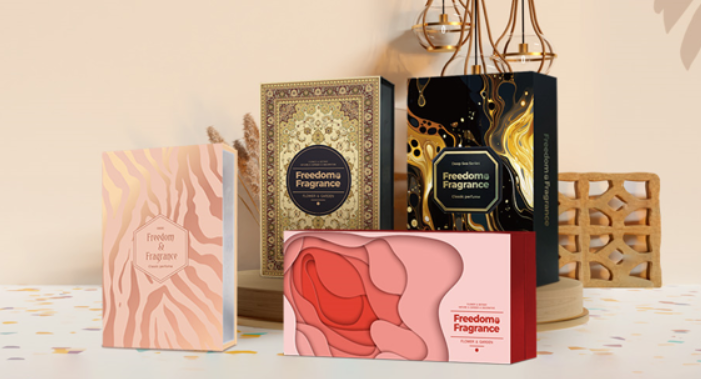- All
- Product Name
- Product Keyword
- Product Model
- Product Summary
- Product Description
- Multi Field Search
Views: 202 Author: XianDa Publish Time: 2025-02-02 Origin: Site

Content Menu
● The Perfume Box: A Comprehensive Exploration of Design, Production, and Significance
● Understanding the Importance of Perfume Packaging
● The Manufacturing Process of Perfume Boxes
● Visuals in Perfume Box Manufacturing
● The Role of Technology in Perfume Box Factories
● Challenges in Perfume Box Manufacturing
● Frequently Asked Questions (FAQs)
Perfume boxes are not just mere containers; they are an integral part of the fragrance experience. The design and manufacturing of perfume boxes involve a meticulous process that combines artistry with engineering, ensuring that each box not only protects its contents but also enhances the overall brand image. This article delves into the intricacies of perfume box manufacturing, focusing on the role of a perfume box factory, the production processes involved, and the importance of packaging in the perfume industry.
Brand Identity: The perfume box is often the first point of contact between a customer and a fragrance. A well-designed box can communicate the essence of the brand, evoke emotions, and attract potential buyers.Protection: Beyond aesthetics, perfume boxes serve a practical purpose. They protect delicate bottles from damage during transportation and storage, ensuring that the fragrance remains intact.Sustainability: With increasing awareness about environmental issues, many perfume box factories are adopting sustainable practices. This includes using recyclable materials and minimizing waste during production.
The production of perfume boxes involves several key steps:
Design Conceptualization: The process begins with brainstorming ideas for the box design. Designers create sketches and digital models to visualize how the final product will look.
Material Selection: Choosing the right materials is crucial. Common materials include cardboard, paperboard, and sometimes eco-friendly options like recycled materials.
Precision Cutting: Once the design is finalized, the materials are cut into specific shapes using advanced machinery to ensure accuracy.
Printing Techniques: High-quality printing techniques such as offset printing or digital printing are employed to apply graphics and branding elements onto the box.
Finishing Touches: Techniques like embossing, foil stamping, and UV coating are used to add texture and visual appeal to the boxes.
Assembly: The cut and printed materials are then folded and glued together to form the final box structure.
Quality Control: Each box undergoes rigorous quality checks to ensure it meets industry standards before being packaged for shipment59.

To better understand this process, consider these visuals:
Design Sketches: Initial concepts often start as hand-drawn sketches or digital renderings.Design Sketch
Cutting Process: Advanced cutting machines in action.Cutting Process
Printing Techniques: Examples of various printing methods used in production.Printing Techniques
Finished Products: A showcase of beautifully crafted perfume boxes ready for market.Finished Products
Modern perfume box factories leverage technology to enhance efficiency and precision in production:
3D Modeling Software: Designers use software to create detailed 3D models of perfume boxes before production begins.
Automated Cutting Machines: These machines ensure that cuts are precise, reducing material waste.
Digital Printing Technology: Allows for high-quality prints with vibrant colors and intricate designs.
While creating perfume boxes can be an exciting venture, there are challenges that manufacturers face:
Material Costs: Fluctuations in material prices can affect production budgets.
Sustainability Pressures: Meeting consumer demands for eco-friendly packaging requires innovation and investment.
Market Competition: Standing out in a crowded market necessitates unique designs and high-quality finishes610.
The journey from concept to shelf for a perfume box is complex yet fascinating. With a focus on sustainability, quality, and innovative design, perfume box factories play a pivotal role in shaping consumer perceptions and enhancing brand loyalty. As trends evolve, so too will the methods employed in manufacturing these essential components of the fragrance industry.

What materials are commonly used for perfume boxes?
Common materials include cardboard, paperboard, and eco-friendly options like recycled paper.
How does packaging affect consumer buying decisions?
Attractive packaging can draw customers' attention and influence their perception of product quality.
What printing techniques are used in perfume box manufacturing?
Techniques such as offset printing, digital printing, embossing, foil stamping, and UV coating are commonly used.
How can I ensure my perfume box stands out on shelves?
Focus on unique designs, high-quality finishes, and effective branding elements to attract attention.
What role does sustainability play in modern perfume packaging?
Sustainability is increasingly important as consumers prefer brands that use eco-friendly materials and practices.